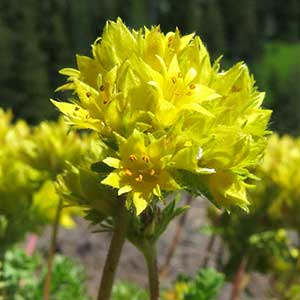Ivesia gordonii
Ivesia pickeringii
alpine ivesia, alpine mousetail, Gordon's ivesia
Pickering's ivesia, silky mousetail
prostrate to erect, (0.2–)0.5–4 dm.
ascending to erect, 3–5 dm.
tightly to loosely cylindric, (1–)3–20(–25) cm; sheathing base ± glandular abaxially, otherwise glabrous;
petiole 0.5–8 cm, hairs 0.2–0.5 mm;
leaflets (6–)10–25 per side, (1–)2–13(–18) mm, glabrous or ± hirsute or villous, glandular-puberulent or -pubescent, lobes (2–)4–8(–15), linear or narrowly oblanceolate to obovate, apex rarely setose.
8–20 cm; sheathing base ± strigose abaxially;
stipules linear to narrowly lanceolate, 3–5 mm;
petiole 1–3.5 cm, hairs abundant, ascending to spreading, 1–2 mm;
leaflets 35–50 per side, loosely overlapping, 2–6 mm, lobes 3–5, oblanceolate to obovate or oval, hairs abundant, ± ascending, 1–2(–3) mm.
1(–2), not paired.
5–10.
5–50(–70)-flowered, 1–8(–11) cm diam.;
glomerules 1–several.
10–100-flowered, (1.5–)5–15 cm diam., flowers usually arranged individually, sometimes more congested.
1–3(–5) mm.
(1–)2–10 mm.
5–12 mm diam.;
epicalyx bractlets linear to narrowly elliptic, (0.5–)1–3.5(–4) mm;
hypanthium turbinate to campanulate, (1.5–)2–4(–4.5) × 2–4(–5) mm;
sepals (2–)2.5–5(–6) mm, obtuse to ± acute;
petals yellow, narrowly oblanceolate to narrowly spatulate, (1–)1.5–3 mm;
stamens 5, filaments 1.3–2.5 mm, anthers yellow, sometimes red-margined, 0.5–1 mm;
carpels (1–)2–4(–6), styles 2.5–4.5(–6) mm.
8–13 mm diam.;
epicalyx bractlets linear-lanceolate to lanceolate, (1.8–)2–2.5 mm;
hypanthium cupulate to turbinate, 1.5–3 × 2.5–4 mm, often nearly as deep as wide;
sepals often purple-suffused or -mottled, (2.5–)3–5 mm, acuminate;
petals white, becoming pink-tinged with age, oblanceolate to narrowly spatulate, (2.8–)3–5(–6) mm;
stamens 20, filaments filiform, 1.5–2.3 mm, anthers white to cream, 0.3–0.6 mm;
carpels 2–4, styles 2.5–3.5 mm.
grayish brown to mottled brown, ± 2 mm.
dark brown, 2.5–3 mm.
Ivesia gordonii
Ivesia pickeringii
Varieties 4 (4 in the flora).
Ivesia gordonii is the most widespread species of the genus, occurring from Washington to Montana, south to central California and Colorado. The species can be distinguished from other members of sect. Ivesia by the relatively deep hypanthium, which is about as deep as wide. Four varieties are provisionally recognized here (B. Ertter and J. L. Reveal 2007), with the likelihood that future work may indicate additional and/or alternate circumscriptions. Populations that are difficult to assign to a variety can be found where the recognizable taxonomic units come together, for example, in northeastern Utah and western Wyoming, involving var. gordonii and var. wasatchensis, and in California and central Idaho where var. alpicola and var. ursinorum tend to merge.
(Discussion copyrighted by Flora of North America; reprinted with permission.)
Of conservation concern.
Ivesia pickeringii is known from Siskiyou and Trinity counties. Some early treatments (for example, P. A. Rydberg 1898, 1908–1918; W. L. Jepson [1923–1925], 1909–1943, vol. 2) conflated this species with I. aperta, hence reports of I. pickeringii in the Sierra Nevada. Historic collections from Edgewood, at the headwaters of the Shasta River in Siskiyou County, have inflorescences more glomerulate than elsewhere in the species range.
The chromosome count of 2n = 28 (P. A. Munz 1959) needs confirmation. If based on Kruckeberg 3665, which was distributed as a voucher for that count, the determination of this collection has been changed to Ivesia sericoleuca.
(Discussion copyrighted by Flora of North America; reprinted with permission.)
1. Leaflets 7–13(–18) mm, glabrous or sparsely hirsute or villous marginally; stems (1–)1.5–4 dm; inflorescences usually branched, 2–8(–11) cm diam., glomerules (1–)2–6(–10), ± capitate. | var. wasatchensis |
1. Leaflets (1–)2–7(–9) mm, hairy or ± glabrous except marginally ciliate; stems (0.2–)0.5–2.5 dm; inflorescences simple or branched, 1–3(–5) cm diam., glomerules 1(–3), ± capitate to loosely congested | → 2 |
2. Stems usually prostrate to ascending, rarely nearly erect, usually dark reddish, minutely glandular or glandular-puberulent to -pubescent; leaves to 0.8 cm diam.; anthers usually red-margined. | var. ursinorum |
2. Stems usually ascending to erect, sometimes decumbent, usually greenish, rarely reddish, hirsute to villous, glandular-puberulent to -pubescent; leaves to 1.5 cm diam.; anthers rarely red-margined | → 3 |
3. Stems usually hirsute to villous, sometimes densely so, glandular-pubescent or eglandular; basal leaves (3–)5–10(–15) cm; flowers 7–12 mm diam.; e Idaho and w Montana to Utah, Wyoming, and w Colorado. | var. gordonii |
3. Stems not or sparsely hirsute to villous, glandular-puberulent or -pubescent; basal leaves 2–8(–10) cm; flowers 5–9 mm diam.; s Washington to California and e to w Montana. | var. alpicola |


